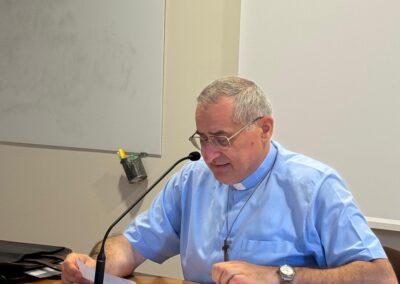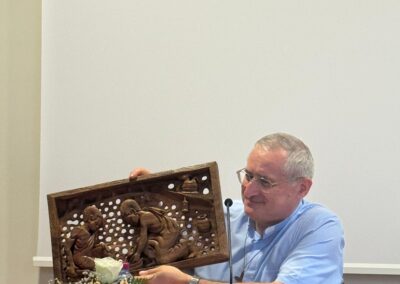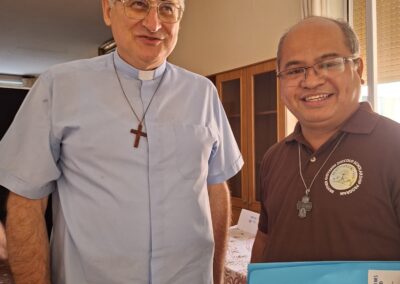Within the richly symbolic setting of the International Congress of the Canossian Lay Association, a particularly awaited and heartfelt moment unfolded: the address by Fr. Antonio Papa, former Superior General of the Canossian Fathers. His reflection, entitled “Maddalena the Pilgrim – A Woman of Relationship”, opened the day not as a conventional lecture, but as a deeply personal sharing — the voice of a brother and witness intimately involved in the journey of faith and mission.
With warmth and sincerity, Fr. Papa retraced the spiritual heritage of St. Magdalene of Canossa — not merely from the perspective of a former superior, but as a son profoundly shaped by her charism. His tone was one of lived experience, not abstraction; a spiritual dialogue rather than theological discourse.
He began by linking the significance of the Jubilee pilgrimage with the call to rediscover Magdalene’s witness as a sign of God’s presence and a model of sanctity. Drawing upon Lumen Gentium and numerous Canossian texts, he delved into Magdalene’s inner pilgrimage: not only her arduous physical journeys, which cost her health and strength, but above all the interior path — from self-reliance to total surrender to God. From doing for God to being wholly of God and with God.
He portrayed her as a “woman of relationship” — capable of profound bonds, spiritual motherhood, and mature, generative friendships. Particularly moving was his reflection on her rich correspondence with Countess Carolina Durini — a spiritual friendship spanning three decades, marked by shared discernment and mission.
With passion and clarity, Fr. Papa noted that Magdalene was synodal long before the word gained currency in Church language. Her constant dialogue with the Church, with pastors, and with spiritual guides — her ability to face figures such as St Gaspar Bertoni or Antonio Rosmini with both humility and firmness — revealed a fidelity to the charism entrusted to her that was both courageous and grace-filled.
The theme of hope — central to the Jubilee — ran through his entire reflection. Quoting Benedict XVI’s Spe Salvi and drawing on the luminous figure of St Josephine Bakhita, he described Christian hope as the ability to “see beyond” the darkness, to perceive signs of life even in the opacity of reality — like the hope that springs when one waits for a child to be born, sensing vitality hidden in the unseen. A vivid image drawn from his own family memory.
Hope, he said, is what sustains every pilgrimage: it makes us light, helps us match the pace of others, teaches us to savour the joy of the destination, and transforms us in the expectation of return. A compelling invitation to walk together: rooted in the Word, nourished by the Eucharist, guided by the poor, united in a common desire to follow Christ in charity.
In closing, he offered two powerful spiritual images: one from St Ambrose, who urged us to open the doors of our hearts to Christ as one crosses a Holy Door; the other from St Augustine, who reminds us that all external teaching must ultimately lead to an encounter with the inner Teacher.
Fr. Papa’s presence and words were not merely a lecture — they were a living testimony to the Canossian charism today. A call to continue walking together, led by Love.








